| Cave fauna 5 - Liphistius |
|
LIPHISTIUS
There are several species of Liphistius spiders in Malaysia. Six of those are cave dwelling, Liphistius batuensis, L. kanthan, L. langkawi, L. panching, L. tempurung and L. priceae sp. nov.. Of these 6, 2 were officially named at the end of 1997. They are Liphistius kanthan Platnick, 1997 and L. tempurung Platnick, 1997 and were found in Gua Kanthan and Gua Tempurung in Perak. L. priceae sp. nov. was described by Schwendinger in 2017 and comes from Dabong in Kelantan and is named after me. Liphistius tioman is not included as a cave dweller as it was found in granite boulders.
The Liphistius are trapdoor spiders and can be described as living fossils, because unlike present day spiders, they have segmented abdomens. They possibly date back to the Carboniferous (360-286 mya) period, as some members of the Liphistiidae family were known to exist 290 mya. Today the genus Liphistius are only found in tropical south east Asia. The Liphistius has even been mentioned in the 1994 Guinness Book of World Records for being the most elusive of all spiders.
All the Malaysian Liphistius species are protected under the Malaysian Wildlife Conservation Bill 2010 and 2012 amendment. Liphistius kanthan is now on the IUCN Red List as critically endangered. There is a possibility that Gua Kanthan will be quarried, which would mean the end of Liphistius kanthan. See more on s 2013 and s 2014 and also on my blog.
The Liphistius builds its nest on the cave wall or floor and camouflages it with mud and dirt. The front door of the nest is a trapdoor with 6-8 signal threads or trip wires radiating out. The spider waits with one leg on each thread, and if prey trips the wire, the spider rushes out, catches the victim and runs home slamming the door. If however the prey turns out to be an enemy, the spider can escape by means of a back door.
After mating the female hangs an egg sac below her nest. The juveniles leave this sac and make their own nests (Price 1998d).
The first 8 photos were taken in Dark Cave, at Batu Caves, Selangor -
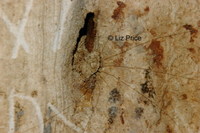
Liphistius batuensis, feet visible on each tripwire |
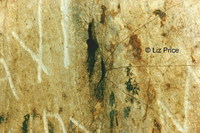
same, but no feet visible |
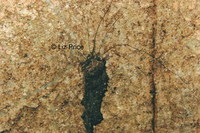
a trapdoor on the wall |
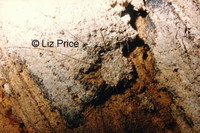
another nest on wall |
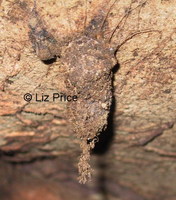
on wall |

on wall |
I've never managed to take any good photos of the actual spider
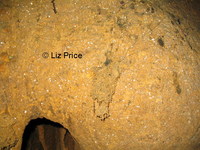
on wall, Dark Cave |
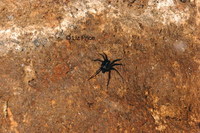
Liphistius batuensis |
The following Liphistius are from Perak. See more on Liphistius kanthan.
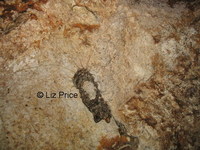
Liphistius kanthan |
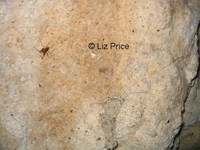
L kanthan nest & cricket |
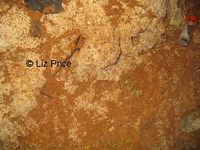
L tempurung in Gua Cicak, well camouflagued |
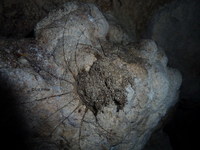
Liphistius kanthan |
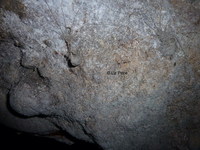
L. kanthan 2 nests side by side |
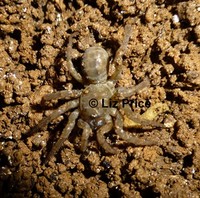
Liphistius kanthan |
A clip of David Attenborough looking at Liphistius Malayanus.
A nonscientific note - trapdoor spiders made several appearances in the 2002 David Arquette film Eight Legged Freaks.
Refs :
BULLOCK, J.A. (1966) The fauna of Pulau Tioman, 9. Introductory report on the terrestrial Arthropods. Bull. Nat. Mus. S'pore, p104-128.
Encyclopedia of Life, EoL, Liphistius kanthan , Kanthan Cave trapdoor spider.
IUCN Red List - Liphistius kanthan.
Malaysian Wildlife Conservation Bill 2010 and the 2012 amendment.
PLATNICK, N; SCHWENDINGER, P, & STEINER, H, (1997) Three new species of the spider genus Liphistius (Araneae, Mesothelae) from Malaysia. American Museum Novitates (New York), No 3209, 13pp.
PLATNICK, N.I. & SEDGEWICK, W.C. (1984) A revision of the spider genus Liphistius (Araneae, Mesothelae). American Museum Novitates, (New York), No 2781, 31pp.
PRICE, L, (1998a) Two new species of cave dwelling trapdoor spiders in Malaysia. Caves & Caving, Autumn 1998, 81: 20, 2 phot. [Liphistius spp.]
PRICE, L, (1998b) Two new cave dwelling Malaysian species of Liphistius. Cerberus, S.S. Jnl, Apr, 24, 3: 50.
PRICE, L, (1998d) Collecting trapdoor spiders. Malaysian Naturalist 51, 3-4(June): 14-19.
PRICE, L, (1998f) New species of cave spider. International Caver, 23: 41.
PRICE, L. (2013) QUARRYING: Gua Kanthan spider endangered. New Straits Times, 4 July 2013.
PRICE, L. (2013) Save endangered Gua Kanthan trapdoor spider. The Star, 4 July 2013.
PRICE, L. (2013) Save the Kanthan spider now. The Sun Daily 4 July 2013.
PRICE, L. (2013) Liphistius Kanthan Needs to be Saved. Ipoh Echo, 16 July 2013.
PRICE, L. (2013) Spectacular Malaysian Cave in Danger of Being Quarried. Caving News, Sept 20th.
SCHWENDINGER, P, (2017) A revision of the trapdoor spider genus Liphistius (Mesothelae: Liphistiidae) in peninsular Malaysia; part 1. Revue suisse de Zoologie (September 2017) 124(2): 391-445.

L. priceae sp. nov. |

© Liz Price 2008 - 2017
Page last updated 23 Nov 2017
All images are copyright © Liz Price
|
|